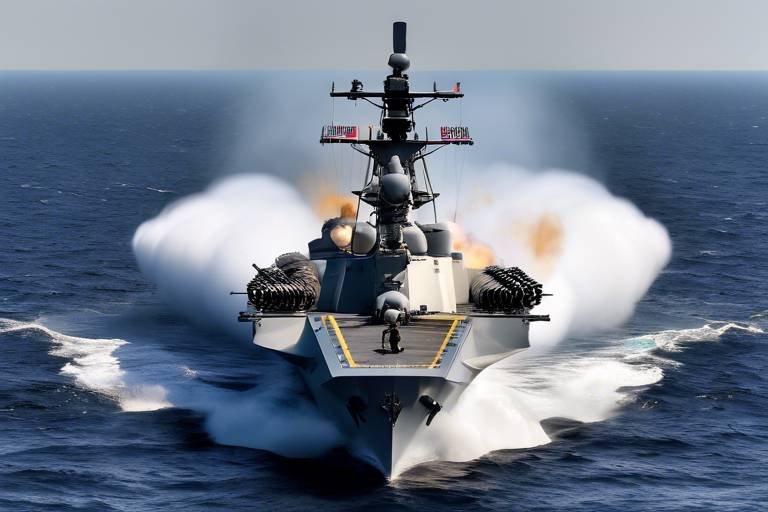The Development of the LRASM Anti-Ship Missile
The Long Range Anti-Ship Missile (LRASM) represents a significant leap forward in naval warfare technology, designed to address the evolving challenges of modern maritime conflicts. As global tensions rise and naval engagements become more complex, the need for advanced weaponry like the LRASM has never been more pronounced. This missile is not just another addition to the U.S. Navy's arsenal; it symbolizes a transformative approach to engaging surface threats. Imagine a tool that can strike with precision from vast distances, keeping sailors safe while ensuring enemy vessels are kept at bay. The LRASM is that tool, and its development is a story of innovation, strategy, and foresight.
The journey of the LRASM began in response to the changing nature of naval warfare, where traditional methods of engagement were becoming less effective against sophisticated adversaries equipped with advanced defense systems. The missile's development reflects a broader trend towards utilizing technology to enhance combat effectiveness. This includes integrating cutting-edge features such as stealth technology and autonomous targeting systems. In essence, the LRASM is designed to outsmart and outmaneuver enemy defenses, much like a chess player anticipating their opponent's moves several steps ahead.
Moreover, the LRASM's significance extends beyond its technical capabilities; it embodies a strategic shift in how the U.S. Navy approaches maritime security. With an ever-growing list of potential threats, including state and non-state actors, the LRASM serves as a critical deterrent, signaling to adversaries that the U.S. is prepared to defend its interests vigorously. This missile is not merely an offensive weapon; it is a cornerstone of the Navy's strategy to maintain dominance in contested waters.
As we delve deeper into the LRASM's features and implications, it becomes clear that this missile is more than just a piece of hardware. It represents a fusion of technology and strategy, highlighting the U.S. commitment to staying ahead in the ever-changing landscape of naval warfare. The development of the LRASM is a testament to human ingenuity and the relentless pursuit of excellence in defense capabilities.
Background of Anti-Ship Missiles
To truly appreciate the significance of the Long Range Anti-Ship Missile (LRASM), it’s essential to delve into the history and evolution of anti-ship missiles. These weapons have undergone a remarkable transformation since their inception, reflecting not only advancements in technology but also shifts in naval warfare tactics over the decades. The journey began during World War II, where the first iterations of anti-ship missiles were rudimentary at best. Back then, naval battles were primarily fought with guns and torpedoes, but the introduction of guided missiles marked a revolution in maritime combat.
As the Cold War unfolded, the need for more sophisticated weaponry became apparent. The development of anti-ship missiles accelerated, with nations recognizing the importance of striking enemy vessels from a distance. The Soviet Union, for instance, pioneered the use of the P-15 Termit missile, which showcased the potential of these weapons to alter the balance of naval power. This missile, often referred to as the "Styx," could be launched from various platforms, making it a versatile tool in maritime warfare.
Fast forward to the 21st century, and we see a landscape dominated by technological advancements. Modern anti-ship missiles are equipped with advanced guidance systems, allowing them to navigate complex environments and engage targets with pinpoint accuracy. The integration of GPS technology and sophisticated sensors has made it possible for these missiles to operate effectively in contested waters, where traditional navigation methods might falter.
Moreover, the rise of stealth technology has played a pivotal role in the evolution of anti-ship missiles. The ability to evade detection by enemy radar systems is now a fundamental aspect of missile design. This shift is not merely a trend; it's a necessity in a world where naval engagements are increasingly characterized by asymmetrical warfare and the need for surprise attacks. The LRASM, for instance, embodies this evolution, showcasing features that enable it to operate undetected and strike with lethal efficiency.
In summary, the background of anti-ship missiles is a fascinating chronicle of innovation and adaptation. From their humble beginnings to the sophisticated systems we see today, these missiles have continually evolved to meet the demands of modern warfare. As we look to the future, the ongoing advancements in missile technology promise to further redefine naval combat, ensuring that anti-ship missiles remain a vital component of maritime strategy.
Key Features of LRASM
The Long Range Anti-Ship Missile (LRASM) is not just another weapon in the U.S. Navy's arsenal; it's a game-changer. With the evolving landscape of naval warfare, the LRASM brings a suite of advanced features that enhance its effectiveness against modern maritime threats. Let's dive into what makes this missile a formidable force on the battlefield.
One of the standout attributes of the LRASM is its stealth technology. In today’s world, where detection can mean the difference between success and failure, stealth is paramount. The LRASM is designed with a focus on minimizing its radar cross-section, which is crucial for evading enemy radar systems. By reducing visibility, the missile increases its chances of successfully engaging high-value maritime targets without being intercepted. Think of it as a ninja in the night—silent, unseen, and deadly.
Stealth technology isn't just about being hard to see; it's about being smart. The LRASM's design incorporates innovative materials and shapes that scatter radar waves, making it challenging for enemy systems to lock onto it. This stealth capability is complemented by its electronic warfare capabilities. Imagine the LRASM not only flying under the radar but also jamming enemy communications and disrupting their radar systems. This dual approach enhances its operational effectiveness, allowing it to strike when the enemy is least prepared.
The meticulous engineering behind the LRASM's radar cross-section is a testament to modern military design. By focusing on reducing its visibility, the missile ensures that it can navigate through contested environments with greater survivability. This aspect is crucial not just for the missile itself but also for the overall mission success of naval operations. When a missile can evade detection, it opens up a world of tactical possibilities for the Navy.
Furthermore, the integration of electronic warfare capabilities means that the LRASM can effectively blind the enemy before it strikes. This capability allows the missile to operate in environments where traditional weapons might falter, making it a versatile asset in various operational scenarios. The combination of stealth and electronic warfare creates a multi-layered approach to engagement that is difficult for adversaries to counter.
Another key feature that sets the LRASM apart is its autonomous targeting system. Imagine a missile that can think for itself—well, that's essentially what LRASM does. Utilizing advanced algorithms and sophisticated sensors, it can identify and engage targets without the need for constant input from operators. This autonomy not only streamlines the attack process but also significantly increases response times. In a fast-paced naval environment, every second counts, and LRASM ensures that the U.S. Navy can act swiftly and decisively.
The autonomous targeting capability means that as soon as the LRASM is launched, it can independently assess the battlefield, prioritize targets, and execute its mission with precision. This level of sophistication is a leap forward in missile technology, reflecting a broader trend in military systems toward greater automation and intelligence.
In summary, the LRASM is equipped with a range of features that make it a critical component of the U.S. Navy's strategy. From its stealth technology that keeps it hidden from enemy eyes to its autonomous targeting capabilities that allow it to operate independently, the LRASM represents the forefront of modern military technology. As naval warfare continues to evolve, the LRASM is poised to adapt and maintain its edge, ensuring that the U.S. Navy remains a dominant force on the high seas.
Stealth Technology
The concept of has revolutionized modern warfare, and the Long Range Anti-Ship Missile (LRASM) is no exception. At its core, stealth technology is all about evading detection. Imagine trying to sneak into a party without being noticed; that’s essentially what LRASM does in the vast ocean. By minimizing its radar cross-section, LRASM can glide through enemy defenses like a shadow in the night, making it a formidable adversary against high-value maritime targets.
One of the primary ways LRASM achieves this is through its unique design. The missile's shape and materials are meticulously engineered to reflect radar waves away from the source rather than back towards it. This is akin to a ninja using the environment to blend in and avoid the watchful eyes of guards. The result? A significant reduction in visibility to enemy radar systems, which is crucial in today's contested environments.
But that’s not all. LRASM also employs advanced materials that absorb radar waves, further enhancing its stealth capabilities. This multi-faceted approach to stealth means that even the most sophisticated radar systems may struggle to detect it until it’s too late. To put it simply, LRASM is like a ghost ship, appearing out of nowhere to deliver a devastating strike.
Furthermore, the integration of electronic warfare capabilities into LRASM's design amplifies its stealth features. By disrupting enemy communications and radar systems, LRASM can create a tactical fog, making it even harder for adversaries to track and respond to its approach. This combination of stealth and electronic warfare is like a magician performing a trick, leaving the audience bewildered and unable to comprehend what just happened.
As we look to the future, the ongoing advancements in stealth technology will only enhance LRASM's capabilities. With each upgrade, the missile becomes more elusive, ensuring that it remains a critical asset in the U.S. Navy's arsenal. In a world where naval warfare is becoming increasingly complex, LRASM’s stealth technology is not just an advantage; it’s a necessity for maintaining maritime superiority.
- What is LRASM?
LRASM stands for Long Range Anti-Ship Missile, designed for the U.S. Navy to engage and destroy enemy ships at long distances. - How does stealth technology work in LRASM?
Stealth technology in LRASM minimizes its radar cross-section and employs materials that absorb radar waves, making it harder for enemy radar systems to detect. - Why is stealth technology important in naval warfare?
Stealth technology allows missiles like LRASM to evade detection, increasing the chances of successful engagement against high-value maritime targets. - What are the electronic warfare capabilities of LRASM?
LRASM can disrupt enemy communications and radar systems, enhancing its operational effectiveness during missions.
Radar Cross Section
The Radar Cross Section (RCS) of a missile is a critical factor in its ability to evade detection and successfully engage targets. In the case of the Long Range Anti-Ship Missile (LRASM), the design philosophy revolves around minimizing its RCS, which directly enhances its stealth capabilities. Imagine trying to spot a small fish in a vast ocean; the smaller and less reflective the fish, the harder it is to see. Similarly, a reduced RCS makes the LRASM much more difficult for enemy radar systems to detect, allowing it to approach high-value maritime targets without being intercepted.
To achieve a low RCS, engineers employ various techniques, including:
- Shaping: The overall shape of the missile is designed to deflect radar waves away from the source, much like how a stealth aircraft is crafted.
- Material Selection: Use of radar-absorbent materials (RAM) helps in further reducing the missile's radar visibility.
- Surface Treatments: Special coatings can be applied to the missile’s surface to absorb radar waves, contributing to a lower RCS.
These techniques work in concert to ensure that the LRASM can penetrate contested environments with a significantly reduced risk of detection. The implications of a low RCS are profound; it not only increases the likelihood of a successful strike but also forces adversaries to invest in more sophisticated detection systems, thereby stretching their resources thin. This cat-and-mouse game of stealth and detection is at the heart of modern naval warfare, where the ability to remain undetected can mean the difference between success and failure in a conflict.
In summary, the LRASM's radar cross-section is a testament to advanced engineering and design. By minimizing its visibility to enemy radar systems, the missile enhances its operational effectiveness, ensuring that it can engage targets with greater confidence and precision. This capability is crucial as naval warfare continues to evolve, and the importance of stealth becomes ever more pronounced in the face of emerging threats.
- What is Radar Cross Section? RCS is a measure of how detectable an object is by radar; a smaller RCS indicates a lower likelihood of detection.
- How does LRASM achieve a low RCS? Through advanced shaping, material selection, and surface treatments that minimize radar reflections.
- Why is a low RCS important for naval missiles? It enhances the missile's chances of evading enemy detection and successfully engaging targets.
Electronic Warfare Capabilities
The Long Range Anti-Ship Missile (LRASM) isn't just about sheer firepower; it also brings a sophisticated suite of to the table. In the modern battlefield, where information is as crucial as ammunition, having the ability to disrupt enemy systems can be a game changer. Imagine a stealthy missile that not only targets its enemy but also blinds them to its approach. That's LRASM for you!
One of the standout features of LRASM's electronic warfare suite is its ability to jam communications and radar systems. This capability allows the missile to create a fog of war, making it difficult for the enemy to coordinate their defense. When LRASM is in play, adversaries face a dual threat: the missile itself and the confusion it sows among their ranks. This is particularly effective against surface vessels that rely heavily on radar for early detection and situational awareness.
Moreover, LRASM employs advanced algorithms that enhance its signal intelligence capabilities. These algorithms allow the missile to analyze the electromagnetic spectrum, identifying critical targets and their defensive systems. By understanding the enemy's communication patterns, LRASM can choose the right moment to strike, maximizing its chances of success. It's like having a chess master at the helm, always thinking several moves ahead.
To illustrate how LRASM integrates these electronic warfare capabilities, consider the following table:
| Capability | Description |
|---|---|
| Communication Jamming | Disrupts enemy communication channels to hinder coordination. |
| Radar Disruption | Interferes with radar systems, reducing detection probability. |
| Signal Intelligence | Analyzes enemy signals to identify vulnerabilities. |
| Autonomous Targeting | Utilizes electronic data to select and engage high-value targets. |
In essence, LRASM’s electronic warfare capabilities not only enhance its lethality but also provide a significant strategic advantage in naval operations. By complicating the enemy's defense and gathering valuable intelligence, LRASM ensures that the U.S. Navy remains a step ahead in the ever-evolving landscape of maritime warfare.
Autonomous Targeting
The Long Range Anti-Ship Missile (LRASM) is a technological marvel that takes modern warfare to a whole new level, particularly with its system. Imagine a weapon that can decide its own path to a target, much like a hawk soaring through the sky, keenly focused on its prey. This capability is not just a fancy feature; it is a game-changer in how naval engagements are conducted. The LRASM utilizes advanced algorithms and a suite of sophisticated sensors that allow it to identify, track, and engage targets with minimal human intervention. This means that while operators can focus on broader strategic decisions, the missile itself can autonomously navigate complex environments to achieve its mission.
One of the standout features of LRASM’s autonomous targeting is its ability to process vast amounts of data in real-time. By leveraging inputs from multiple sensors, including infrared, radar, and electronic signals, the missile can create a comprehensive picture of the battlefield. This allows it to distinguish between friend and foe, ensuring that it only engages legitimate targets. Think of it as a highly trained sniper who can assess a chaotic scene and still hit their mark with pinpoint accuracy.
Moreover, the efficiency of the LRASM’s targeting system significantly reduces response times. In the fast-paced world of naval warfare, every second counts. The missile’s ability to operate autonomously means it can react to threats faster than a human operator could, which is crucial in high-stakes scenarios where delay can lead to catastrophic outcomes. This capability not only enhances the missile's effectiveness but also provides a strategic advantage to the U.S. Navy, allowing them to maintain the upper hand in contested waters.
To give you a clearer picture of how this works, consider the following table that outlines the key components of the LRASM’s autonomous targeting system:
| Component | Function |
|---|---|
| Advanced Algorithms | Process data and make targeting decisions in real-time. |
| Sensors | Gather information on the environment and potential targets. |
| Data Fusion | Combine inputs from multiple sources for accurate target identification. |
| Autonomous Navigation | Allow the missile to chart its course to the target without human input. |
In summary, LRASM's autonomous targeting technology represents a significant leap forward in military capability. By integrating cutting-edge sensors and algorithms, it not only enhances operational effectiveness but also reshapes the landscape of naval warfare. As adversaries continue to develop their own advanced systems, the importance of such innovations cannot be overstated. The future of naval engagements may very well depend on the ability to leverage autonomous systems like the LRASM effectively.
- What is the primary advantage of LRASM's autonomous targeting?
The primary advantage is its ability to identify and engage targets without constant human input, significantly increasing response times and operational efficiency. - How does LRASM differentiate between friend and foe?
It uses advanced sensors and data processing algorithms to analyze the battlefield and make informed decisions about which targets to engage. - Can LRASM be integrated with other naval systems?
Yes, LRASM is designed for seamless integration with various naval platforms, enhancing overall strike capabilities.
Strategic Importance of LRASM
The Long Range Anti-Ship Missile (LRASM) is not just another weapon in the U.S. Navy's arsenal; it represents a significant leap in naval warfare strategy. As we navigate through increasingly complex maritime environments, the importance of LRASM becomes glaringly apparent. Imagine a chess game where every move counts, and the stakes are higher than ever. That's the nature of modern naval warfare, and LRASM is a game-changer.
One of the most compelling aspects of LRASM is its deterrence factor. The mere presence of this advanced missile system in naval fleets sends a clear message to potential adversaries: the U.S. is serious about maintaining maritime security. In a world where threats constantly evolve, having a weapon that can strike from a distance and evade detection is akin to holding a trump card. It signifies not just readiness, but also a commitment to safeguarding interests in contested waters. This deterrence is crucial, especially in regions where tensions run high, such as the South China Sea.
Moreover, LRASM’s integration with various naval platforms amplifies its strategic significance. It is designed to operate seamlessly with surface ships, submarines, and even aircraft, enhancing the overall strike capabilities of the U.S. Navy. This multi-domain operational capability means that the LRASM can be deployed in various scenarios, whether it’s a large-scale conflict or a targeted strike against a high-value target. The flexibility it offers is invaluable, allowing commanders to adapt to rapidly changing circumstances on the battlefield.
In addition, LRASM’s advanced features like autonomous targeting and stealth technology enhance its operational effectiveness. These capabilities enable the missile to identify and engage targets with minimal human intervention, which is crucial in fast-paced combat situations. It’s like having a highly skilled sniper who can make split-second decisions without needing constant guidance. This autonomy not only streamlines the attack process but also significantly reduces response times, which can be the difference between success and failure in naval engagements.
As we look to the future, the ongoing research and development efforts surrounding LRASM ensure that it remains relevant against emerging threats. The landscape of naval warfare is constantly evolving, and so too must our capabilities. The U.S. Navy is committed to enhancing LRASM’s features, ensuring it can adapt to new technologies and tactics employed by adversaries. This relentless pursuit of innovation highlights the strategic foresight that underpins the development of LRASM and reaffirms its role as a cornerstone of naval defense strategy.
In summary, the strategic importance of LRASM cannot be overstated. Its deterrence factor, integration capabilities, advanced features, and commitment to continuous improvement make it an essential asset for the U.S. Navy. As we face an uncertain future in maritime security, having a weapon like LRASM ensures that the U.S. remains a formidable force, ready to tackle any challenge that arises on the high seas.
- What is LRASM? The Long Range Anti-Ship Missile (LRASM) is an advanced missile system designed to target enemy ships from long distances with high precision.
- How does LRASM enhance naval strategy? LRASM enhances naval strategy by providing a deterrent against adversaries, integrating with various naval platforms, and utilizing advanced targeting technologies.
- What are the key features of LRASM? Key features include stealth technology, autonomous targeting, and long-range capabilities.
- Why is LRASM important for the U.S. Navy? LRASM is important because it helps maintain maritime security, increases response times, and adapts to evolving threats in naval warfare.
Deterrence Factor
The Long Range Anti-Ship Missile (LRASM) serves as a powerful deterrent in modern naval warfare, acting as a silent guardian of maritime security. Imagine a chess game where every piece on the board has a role, but one piece—LRASM—has the ability to change the game entirely. Its presence alone can shift the balance of power, making potential adversaries think twice before engaging in hostile actions against U.S. naval forces.
One of the most compelling aspects of LRASM is its ability to project strength without the need for immediate engagement. When adversaries know that a fleet is equipped with LRASM, the psychological impact is profound. The missile's long-range capabilities mean that it can strike from a distance, keeping enemies at bay and protecting vital shipping lanes and strategic interests. This is not just about having the weapon; it’s about the message it sends. To illustrate this, consider the following:
| Deterrence Aspect | Description |
|---|---|
| Psychological Impact | Adversaries are less likely to engage due to fear of retaliation. |
| Strategic Reach | Ability to strike targets at significant distances enhances maritime security. |
| Cost of Engagement | Potential adversaries must consider the high stakes and costs associated with attacking a U.S. fleet equipped with LRASM. |
Furthermore, the integration of LRASM into naval operations is a clear signal of the U.S. commitment to maintaining a robust defense posture. It’s akin to having a highly trained guard dog; just the sight of it can deter intruders. In this case, the LRASM acts as that guard dog, ready to defend its territory at a moment's notice. The message is clear: the U.S. Navy is prepared and capable of responding to threats swiftly and decisively.
Moreover, the LRASM's advanced technology allows it to operate in contested environments, further enhancing its deterrent effect. By utilizing stealth and electronic warfare capabilities, the missile can evade detection and disrupt enemy operations, making it a multi-faceted tool in naval strategy. This adaptability means that adversaries cannot simply counter one aspect of its capabilities; they must consider the entire spectrum of threats that LRASM presents.
In conclusion, the deterrence factor of LRASM is not just about the missile itself; it embodies a broader strategy that emphasizes readiness, psychological warfare, and technological superiority. As the geopolitical landscape continues to evolve, the LRASM stands as a testament to the U.S. Navy's commitment to safeguarding maritime interests and projecting strength in the face of potential threats.
- What is the primary purpose of the LRASM?
The LRASM is designed to target enemy ships and submarines effectively, enhancing the U.S. Navy's capabilities in maritime warfare. - How does LRASM's stealth technology work?
LRASM utilizes advanced design techniques to minimize its radar cross-section, making it less detectable by enemy radar systems. - Can LRASM be launched from multiple platforms?
Yes, LRASM is designed for integration with various naval platforms, including surface ships and submarines, allowing for versatile operational deployment. - What role does LRASM play in U.S. naval strategy?
LRASM enhances deterrence, ensures rapid response to threats, and contributes to maintaining maritime dominance in contested areas.
Integration with Naval Platforms
This article explores the evolution, technology, and strategic implications of the Long Range Anti-Ship Missile (LRASM), highlighting its significance in modern naval warfare and defense strategies.
Understanding the history and evolution of anti-ship missiles provides context for the development of LRASM, showcasing advancements in technology and changing naval warfare tactics over the decades.
The LRASM boasts advanced features such as stealth technology, autonomous targeting, and long-range capabilities, making it a formidable weapon in the U.S. Navy's arsenal against surface threats.
Stealth technology is crucial for LRASM's effectiveness, allowing it to evade detection by enemy radar systems, thereby increasing its chances of successful engagement against high-value maritime targets.
The design of LRASM focuses on minimizing its radar cross-section, which is essential for reducing its visibility to enemy detection systems and enhancing survivability in contested environments.
LRASM integrates electronic warfare capabilities that enable it to disrupt enemy communications and radar systems, further increasing its operational effectiveness during missions.
LRASM’s autonomous targeting system utilizes advanced algorithms and sensors to identify and engage targets without requiring constant input from operators, streamlining the attack process and increasing response times.
The LRASM plays a pivotal role in U.S. naval strategy, providing enhanced capabilities to counter emerging threats in maritime environments and ensuring dominance in contested waters.
The presence of LRASM in naval fleets serves as a deterrent to potential adversaries, signaling the U.S. commitment to maintaining maritime security and readiness in the face of evolving threats.
LRASM is designed for seamless integration with various naval platforms, including surface ships and submarines, enhancing the overall strike capabilities of the U.S. Navy in multi-domain operations. This flexibility ensures that the missile can be deployed from different platforms, allowing for a diverse range of operational scenarios. For instance, when launched from a Virginia-class submarine, LRASM can engage targets from underwater, providing a stealthy approach that traditional surface ships cannot match. Similarly, when deployed from Arleigh Burke-class destroyers, it can leverage the ship’s advanced radar and targeting systems to maximize its effectiveness.
Moreover, the integration of LRASM with naval platforms is not just about hardware compatibility. It also involves sophisticated software systems that enable real-time data sharing and coordination among various units. This interconnectedness allows for a more cohesive operational strategy, where multiple assets can work together to overwhelm enemy defenses. The table below summarizes the key naval platforms compatible with LRASM:
| Naval Platform | Type | Launch Capability |
|---|---|---|
| Virginia-class Submarine | Submarine | Vertical Launch System (VLS) |
| Arleigh Burke-class Destroyer | Destroyer | Vertical Launch System (VLS) |
| Independence-class LCS | Corvette | Modular Payload System |
As the U.S. Navy continues to evolve, the integration of LRASM with these platforms ensures that it remains at the forefront of naval warfare, adapting to new threats and challenges. This adaptability not only enhances the Navy's operational capabilities but also reinforces its strategic posture in an increasingly complex global maritime environment.
Ongoing research and development efforts aim to enhance LRASM’s capabilities, ensuring it remains effective against future threats and adapting to the rapidly changing landscape of naval warfare.
- What is LRASM? The Long Range Anti-Ship Missile (LRASM) is a precision-guided missile designed to target enemy ships from long distances.
- How does LRASM differ from traditional anti-ship missiles? LRASM incorporates advanced stealth and autonomous targeting technologies, making it more effective against modern threats.
- What platforms can launch LRASM? LRASM can be launched from various platforms, including submarines and destroyers, enhancing its versatility in naval operations.
- Why is LRASM important for the U.S. Navy? LRASM plays a crucial role in deterring adversaries and ensuring maritime security by providing advanced strike capabilities.
Future Developments and Upgrades
The Long Range Anti-Ship Missile (LRASM) is not just a weapon of today; it is a glimpse into the future of naval warfare. As global threats evolve and become more sophisticated, so too must the technologies that protect maritime interests. The U.S. Navy recognizes this necessity and is investing heavily in the ongoing development and upgrade of the LRASM system. These enhancements are aimed at ensuring that the missile remains a cutting-edge tool in its arsenal, capable of addressing both current and future challenges.
One of the most exciting aspects of the future of LRASM is its potential for increased autonomy. Current upgrades are focused on refining the missile’s autonomous targeting systems, which utilize advanced algorithms and artificial intelligence to identify and engage targets with minimal human intervention. This means that in the heat of battle, the LRASM could make split-second decisions, improving response times and effectiveness against fast-moving maritime threats.
Moreover, the integration of next-generation sensors is on the horizon. These sensors will enhance the missile's ability to detect and track targets in various environmental conditions, including adverse weather. With improved target recognition capabilities, LRASM will be able to differentiate between friend and foe more effectively, reducing the risk of collateral damage and increasing mission success rates.
Another critical area of development involves cybersecurity measures. As warfare becomes increasingly digitized, the LRASM must be protected from cyber threats that could compromise its operational integrity. Future upgrades will focus on fortifying these systems to ensure they remain resilient against hacking attempts and electronic warfare tactics employed by adversaries.
Furthermore, the U.S. Navy is exploring the possibility of enhancing LRASM's range and payload capacity. By integrating advanced propulsion systems, the missile could potentially strike targets further away, giving naval forces a strategic advantage in preemptively neutralizing threats before they can engage friendly vessels. This could alter the dynamics of naval engagements, allowing for a more flexible and proactive defense posture.
In addition to technological advancements, the LRASM program is also looking at interoperability with allied forces. As global partnerships become more critical in addressing maritime security challenges, ensuring that LRASM can operate seamlessly alongside allied weapon systems is essential. This could involve software upgrades and communication protocols that allow for joint operations, enhancing collective defense capabilities.
To summarize, the future of the LRASM is bright and filled with potential. As the U.S. Navy continues to invest in research and development, we can expect to see a missile system that not only meets the challenges of today but is also prepared for the uncertainties of tomorrow. The ongoing upgrades will ensure that LRASM remains a key player in maintaining maritime superiority and securing national interests on the high seas.
- What is LRASM? The Long Range Anti-Ship Missile (LRASM) is a precision-guided missile designed to target enemy ships from long distances.
- How does LRASM's stealth technology work? LRASM utilizes advanced design features to minimize its radar cross-section, making it less detectable by enemy radar systems.
- What are the key features of LRASM? Key features include autonomous targeting, stealth capabilities, and integration with various naval platforms.
- How is LRASM expected to evolve in the future? Future developments will focus on enhancing autonomy, cybersecurity, range, and interoperability with allied forces.
- Why is LRASM important for U.S. naval strategy? LRASM serves as a deterrent against potential adversaries and enhances the U.S. Navy's capabilities in contested maritime environments.
Frequently Asked Questions
- What is the LRASM and why is it important?
The Long Range Anti-Ship Missile (LRASM) is a cutting-edge weapon developed by the U.S. Navy to address modern naval threats. Its importance lies in its advanced features like stealth technology and autonomous targeting, which significantly enhance the U.S. Navy's capability to engage and neutralize enemy ships from a safe distance, ensuring maritime dominance.
- How does stealth technology enhance the effectiveness of the LRASM?
Stealth technology is a game-changer for the LRASM. By minimizing its radar cross-section, the missile can evade enemy detection systems, making it harder for adversaries to intercept it. This capability increases the likelihood of successful strikes on high-value maritime targets, which is crucial in contested environments.
- Can LRASM operate autonomously?
Absolutely! One of the standout features of the LRASM is its autonomous targeting system. Using sophisticated algorithms and sensors, it can identify and engage targets without needing constant input from operators. This autonomy not only streamlines the attack process but also enhances response times, making it a formidable asset in naval operations.
- What role does LRASM play in U.S. naval strategy?
The LRASM is pivotal in U.S. naval strategy as it provides enhanced capabilities to counter emerging maritime threats. Its presence acts as a deterrent to potential adversaries, signaling a strong commitment to maintaining maritime security and readiness in an ever-evolving threat landscape.
- How is LRASM integrated with naval platforms?
LRASM is designed for seamless integration with various naval platforms, including surface ships and submarines. This versatility enhances the overall strike capabilities of the U.S. Navy, allowing for effective multi-domain operations and ensuring that the missile can be deployed in a variety of combat scenarios.
- What future developments are expected for the LRASM?
Ongoing research and development efforts are focused on enhancing the LRASM's capabilities. As naval warfare continues to evolve, these upgrades will ensure that the LRASM remains effective against future threats, adapting to the rapidly changing landscape of maritime combat.



















